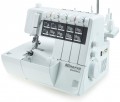Max. stitch width
The maximum stitch width provided by a sewing machine.
Most modern sewing machines are capable of working not only with the simplest longitudinal seam (when punctures with a needle occur strictly one after another), but also with seams that cover a certain width - for example, zigzag and various decorative ones. And in overlockers, such opportunities are generally available by definition.
The larger the maximum stitch width, the correspondingly wider the machine’s ability to work with specific types of seams (all other things being equal). An indicator of up to 5 mm is typical mainly for entry-level devices, 5 - 7 mm - average, 7 mm and more - advanced.
Max. presser foot height
It is the distance from the work surface to the presser foot in the highest position. It must be taken into account when working with thick fabrics.
Features
—
Alphabet letter embroidery. The ability to embroider letters of the alphabet using a machine. This function is found in computerized models. It is carried out due to a set of letters entered into the memory of the machine. Many models with this feature have several built-in fonts, and some even allow you to upload your fonts from your computer.
—
Differential bottom feed. The fabric feed consists of two gear racks — in front of and behind the needle. Depending on the set mode, such a feed can additionally stretch or, conversely, collect fabric during sewing; the first is useful when working with dense fabrics, the second — for knitwear, stretch and other easily stretching materials.
—
Reverse stitching. A function that allows you to switch the direction of movement of the fabric under the needle and, accordingly, the direction of the seam. Mainly used for stitching. The reverse is practically obligatory for sewing machines in the classical sense of the word — electromechanical, computerized and sewing-embroidery (see "Type"), but practically does not occur in other types.
— Free arm. A device for working with sleeves, trousers and other similar parts of clothing. This function is most often implemented due to the removable part of the desktop — when it is removed, the table turns into a narrow platform. The specific width of such a device ma
...y be different, it should be specified separately.
— Needle threader. A special device designed to facilitate the process of threading a needle. The presence of a needle threader is especially useful when changing threads frequently (for example, sewing alternately with different colours).
— Thread cutter. A mechanism for cutting the threads after sewing, eliminating the need to use scissors: to cut the thread, just press the button. Note that we are talking about an automatic thread cutter; hand tools mounted on the bodies of some machines are not considered thread cutters in this case.
— Pedal free sewing. The ability to use the machine without connecting the pedal. To start and stop the process in such models, usually, a special button is provided. Such an opportunity can be useful for long sewing when it would be tiring to keep the pedal constantly depressed, and for occasional use, when the machine starts “for a couple of stitches” and there is no need to fiddle with connecting the pedal.
— Twin needle sewing. The possibility of using a machine for sewing with a twin needle — a pair of needles fixed in one holder. There are different types of such needles and different methods of working with them, and some work is done only with a double needle. Anyway, the use of such devices requires that the machine be initially compatible with them.
— Needle stop switch (top/bottom). A switch that allows the user to select whether the needle will be in the up or down position after the motor stops. In the absence of such a switch, the needle, usually, stops only in the upper position, and this is not always convenientPower consumption
The power consumed by the machine during operation. Usually, the maximum power value is indicated in the characteristics.
Most of the electricity supplied to the machine is consumed by the engine, so this indicator primarily describes the power of the engine. The higher this power, the faster the machine can work and the better it is suitable for working with dense fabrics. However, there is no strict dependence here, much also depends on the general specialization of the unit.
Cover
The type of cover supplied with the sewing machine.
-
Soft. A soft fabric cover protects the machine mainly from dust and dirt and provides almost no protection from bumps and collisions. At the same time, having removed such a cover for the duration of work, it can be folded compactly.
-
Hard. A cover in the form of a hard cover put on from above or a case in which the machine fits. Such a cover is rather bulky, it cannot be folded like a soft one; on the other hand, it protects the machine well both from dirt and from collisions and contact with solid objects.

